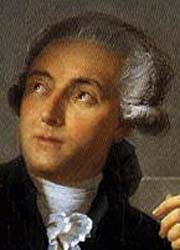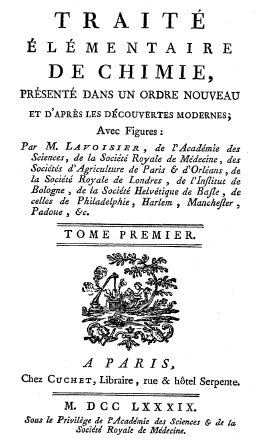1902 Encyclopedia > Antoine Laurent Lavoisier
Antoine Laurent Lavoisier
French chemist
(1743-94)
ANTOINE LAURENT LAVOISIER (1743-1794), one of the founders of modern chemistry, was born in Paris, August 26, 1743. His father, a wealthy tradesman, gave him an excellent education at the College Mazarin, and encouraged his desire to adopt the career of science. On quitting college, he devoted himself to study with extraordinary ardour: he followed the astronomical and mathematical course of Lacaille worked in the laboratory of Rouelle, and took lessons in botany from Jussieu; He renounced all frivolous society, and even restricted himself to a diet of milk in order to repair the damage to his constitution caused by excessive application. His first public distinction was gained on the occasion of a prize offered by the Academy of Sciences for an essay on the best mode of lighting the streets of Paris. To increase the sensitiveness of his eyes, he immersed herself for six weeks in a room hung with black, from which all light was excluded except that of the lamps experimented upon. His zeal was a pledge of success, and was rewarded with the gold medal, April 9, 1766. A multitude of subjects now engaged his attention. He presented to the Academy a masterly analysis of gypsum; travelled through France with Guettard, who was occupied in constructing the first geological map of the country, and composed a work, of which a fragment entitled Mémoire sur les couches des montagnes found a place in the Academy collection for 1789; refuted the prevalent error as to the conversion of water into silica by repeated distillation, and studied the phenomena of thunder and aurorae, of crystallization and congelation. He became an associate of the Academy in 1768, and in 1769 obtained the lucrative post of farmer-general of the revenue, with a view to increase the resources at his command for the advancement of science.

Antoine Laurent Lavoisier (1743-94)
French chemist
It was about the year 1770 that the vast possibilities of the new field opened to the researches of chemists by the pneumatic discoveries of Black, Cavendish, and Priestley were recognized by Lavoisier, and the perception gave to his genius the definitive impulse hitherto wanting to it. He repeated and verified experiments which became, in his hands, the means of invalidating their authors' conclusions, and prepared to import the clear-cut precision of his own ideas into a science as yet illogical in form and incoherent in expression. His wealth and position, as well as his enthusiasm, eminently qualified him to lead a successful reform. He lived in the midst of the most stimulating society of his time. Between him and such men as Laplace, Monge, Berthollet, and Fourcroy the constant interchanae of ideas established a community of opinion in physical matters so close that the separate intellectual property of each was all but completely merged in the general stock. (Footnote 353-1) On one day in each week Lavoisier threw open his laboratory to a select few of his friends, communicated the results of his labours, and invited their criticism and advice. By this consultative system his work gained in solidity, and lost nothing in originality. On the 1st of November 1772 Lavoisier, eager to secure the credit of priority, deposited at the Academy a sealed packet containing the record of his earliest conclusions on the crucial point of metallic oxidation. The discovery by Priestley in 1774 of "dephlogisticated air" materially assisted the development of the innovating doctrine, which took the form of a fully fledged theory when Lavoisier in 1778 assigned to the new substance, with the name of "oxygen," the important functions of the universal "acidifyiug principle." His analysis of water in 1784, and synthesis of "fixed air" (called by him "carbonic acid," Academy Memoirs, 1781), opened the way for an extended view of the composition of organic as well as inorganic substances, and the anti-phlogistic chemistry was completed by the publication, in 1787, of the Méthode de nomenclature chimique. The reform of language effected by Lavoisier in conjunction with Guyton de Morveau, Berthollet, and Fourcroy was an indispensable prelude to the reform of thought. With the current alchemistic jargon science, properly so-called, could have no fellowship. The new terminology prevailed without change for fifty years, and has been fitted, by trifling modifications, to meet the exigencies of recent progress. The acceptance of the it "oxygen theory" was enormously facilitated by the defined and logical form given to it in Lavoisier’s Traité élémentaire de chimie (Paris, 1789). Indeed, the history of science scarcely presents a second instance of a change so fundamental accomplished with such ease. The partisans of phlogiston did not, it is true, abandon the field without a struggle. In Berlin they met Lavoisier’s demonstrations by burning him in effigy, and in Paris Lamétherie conducted, in the Journal de Physique, a fierce polemic against the party of innovation. The controversy was, however, brief, and its issue visibly certain. Before the end of the century the reformed chemistry was everywhere in a position of uncontested triumph.

Title page of the first volume of the Traité élémentaire de Chimie
by A L Lavoisier
The enlightened activity of Lavoisier was no less conspicuous in his administrative than in his scientific capacity. A prominent member of the body of farmers-general during twenty-one years, he obtained the abolition of certain taxes equally onerous and unproductive, and earned the gratitude of the Jews of Metz by relieving them from an oppressive impost. Appointed director of the powder-works by Turgot in 1776, he not only suppressed the vexatious searches for saltpetre in the cellars of private houses, but succeeded in quadrupling the produce of the commodity. He, moreover, improved the manufacture of gunpowder so as to add one-third to its explosive force, thereby reversing the previous superiority of English over French ordnance. His philanthropic, zeal was displayed in the provincial assembly of the Orléanais in 1787. In the year following he was attached to the Caisse d'escompte, and presented a report of its operations, November 21, 1789, to the Constituent Assembly. In 1790 he sat on the commission of weights and measures. In 1791 he became commissary to the treasury, where he established a system of accounts of unexampled punctuality. Requested by the National Assembly to set forth a new scheme of taxation, he composed a treatise De la richesse térritoriale de la France, of which an extract, printed at the public expense, shows him to have been possessed of sound and liberal views on political economy. In short, to quote the words of Lalande, "Lavoisier was to be found everywhere." But those were times when to be conspicuous was to be in peril. On the 2nd of May 1794, Dupin, a member of the Convention, presented a frivolous accusation against the whole of the ex-farmers-general, whose wealth constituted in itself an inexpiable crime. Lavoisier found a hiding-place for a day or two in the deserted apartments of the Academy, but, hearing that his absence was likely to prejudice the cause of his colleagues, he voluntarily gave himself up. He thought it impossible that his life could be taken, but expected the confiscation of his property, when, as he told Lalande, he proposed to earn his bread as an apothecary. Half measures, however, were not in favour with the revolutionary tribunal. On the 6th of May, he, with twenty-seven others of the same profession, was condemned to the guillotine, and, two days later, the sentence was carried into execution. "Il ne leur a fallu," Lagrange remarked, "qu’un moment pour faire tomber cette tête, et cent années peut-être ne suffiront pas pour en reproduire une semblable." [They only needed a moment to make this head fall, and one hundred years will perhaps not suffice to reproduce a similar one.] It is said that a petition presented in his favour met with the brutal reply: "The republic has no need of savants." He was preceded on the scaffold by M. Paulze, whose gifted daughter he had married in 1771. He left no posterity.
To the gift of a transcendent intellect Lavoisier joined the charms of a noble person and winning manners. He was faithful to his friends, charitable to the poor, a model husband, and a patriotic public servant. His fame as the reformer of chemistry rests on no single discovery, but is involved in the first principles of the science (see CHEMISTRY, p. 463). It was his great merit to have made the balance the ultima ratio of the laboratory. Quantitative analysis thus became for the first time possible, and a chemical reaction took in his hands the rigid form of an algebraical equation. (Footnote 353-2) His latest studies were of a physiological character, and M. Dumas (Footnote 353-3) found among his papers a piece showing that he had arrived at a remarkable anticipation of modern views conceming the relations of organic to inorganic nature. He was probably the first to devote systematic attention to agricultural chemistry, and obtained the practical success of doubling the produce of a large farm owned by him near Blois. A striking proof of his disinterested humanity is afforded by a long and painful investigation of putrefying substances carried out solely with a view to averting accidents in sewers. Not the least notable of his achievements is that of having first formed a clear idea as to the nature of gases, and of matter generally in its relation to heat. He held that bodies exist in the solid, liquid, or gaseous states according as the attractive force of their particles is superior, equal, or inferior to the repulsive action of an universally diffused, imponderable fluid which he called "caloric." Differences of specific heat he attributed to differences of inter-molecular space. The theory, put forward by him with due reserve, formed a useful if not indispensable preliminary to further progress. He was the inventor of the gasometer, and, jointly with Laplace, his coadjutor in a series of experiments on specific heat, of the calorimeter.
A complete edition of the writIngs of Lavoisier was issued in four vols. 4to by the Government of Napoleon III, under the title Oeuvres de Lavoisier publiées par les soins de son Excellence le Ministre de l’Instruction publique, Paris, 1864-68. This publication comprises, besides the works already mentioned, Opuscules physiques et chimiques (1774), a large number of memoirs from the Academy volumes (during the twenty years 1770-90 he contributed no less than fifty-eight, and numerous letters, notes, and reports relating to the various affairs in which he was engaged. At the time of his death he was preparing an edition of his collected works, and the portions ready for the press were published by his widow in 1805, in two 8vo. entitled Mémoires de Chimie. The plates in the Traité élémentaire were drawn and engraved by Madame Lavoisier. Biographical notices of Lavoisier are given in Foureroy’s Notice, and by Lalande in Scherer’s Nachträge, Jena, 1796. For an account of his discoveries see Dumas, Leçons sur la Philosophie Chimique, and Béchamp, Lettres Historiques sur la Chimie. (A. M. C.)
Footnotes
(353-1) Oeuvres de Lavoisier, tom. i. p. 13.
(353-2) Oeuvres, tom. i. p. 108.
(353-3) Leçons de Chimie, 1861.
Related Pages: Lavoisier in the History of Chemistry
The above article was written by Miss Agnes Mary Clerke; made astronomical observations at the Cape of Good Hope, 1888; gained the Actonian Prize for her works on astronomy, 1893; author of A Popular History of Astronomy during the Nineteenth Century and Problems in Astrophysics.
|

